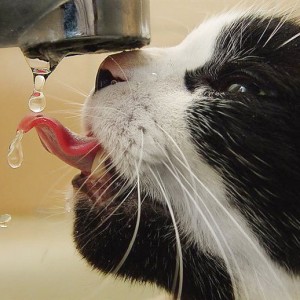News
Archive for May, 2015
Chronic Kidney Disease in Cats
by admin on May 1st, 2015
Category: News, Tags:
 ‘Chronic kidney disease’ (Part 1) is a term used to refer to cats with kidney insufficiency or failure. ‘Chronic’ simply means long term. ‘Insufficiency’ or ‘failure’ means that the kidneys are no longer able to adequately perform their normal tasks. ‘Chronic kidney failure’ refers to the situation where the kidneys have not been able to perform one or more of their normal tasks adequately for a period of time (months to even years). Because the word ‘failure’ evokes such a sense of doom, we often opt for the term ‘chronic renal insufficiency’ or ‘chronic kidney disease’ instead, as many cases can be treated successfully and can look forward to months or often years of quality life.
‘Chronic kidney disease’ (Part 1) is a term used to refer to cats with kidney insufficiency or failure. ‘Chronic’ simply means long term. ‘Insufficiency’ or ‘failure’ means that the kidneys are no longer able to adequately perform their normal tasks. ‘Chronic kidney failure’ refers to the situation where the kidneys have not been able to perform one or more of their normal tasks adequately for a period of time (months to even years). Because the word ‘failure’ evokes such a sense of doom, we often opt for the term ‘chronic renal insufficiency’ or ‘chronic kidney disease’ instead, as many cases can be treated successfully and can look forward to months or often years of quality life.
What do the kidneys do?
The kidneys perform many functions in the body, including:
- helping to maintain fluid balance in the body
- producing certain hormones which stimulate red blood cell production and activate Vitamin D
- regulating blood pressure
- regulating electrolyte balance
- excreting waste products in the urine. Blood is constantly filtered through the kidneys to remove the toxic waste products of the body’s metabolism. Urine is produced in this process.
- concentrating the urine by returning water to the body, preventing dehydration
Fortunately, there is considerable ‘reserve capacity’ in the kidneys. It is well recognised that in healthy animals and humans, it is possible to remove one kidney completely without any adverse consequences due to the capacity of the other kidney to take over normal function. In fact, two thirds to three quarters of the total functioning kidney tissue (of both kidneys) has to be lost before clinical signs of chronic kidney disease develop.
How common is chronic kidney disease in cats?
Chronic kidney disease can affect any cat, of any age, any sex, and any breed. It is most commonly seen in middle to old-aged cats (those over 7 years of age), and it becomes increasingly more common with advancing age. It has been estimated that around 20-50% of cats over 15 years of age will have some degree of chronic kidney disease and it is seen more frequently in cats than in dogs.
What causes chronic kidney disease?
Most cases of chronic kidney disease are considered ‘idiopathic’ (i.e. they have an unknown underlying cause). However, some causes are well known and recognised, including:
- Polycystic Kidney Disease (an inherited disease in Persians/Persian lines where cysts replace normal kidney tissue)
- infections (also called ‘pyelonephritis’, from infection from the bladder or bacteria from blood stream, or the disease Feline Infectious Peritonitis)
- toxins (e.g. antifreeze, certain drugs)
- tumours (e.g. kidney lymphoma)
Other conditions can also gradually affect the kidneys from birth (‘congenital’ defects). Trauma, hypokalaemia (low blood potassium), and hypercalcaemia (high blood calcium) can also be contributory causes of chronic kidney disease in cats.
Intensive research is still on-going in attempt to uncover the underlying cause(s) of most cases of this disease.
If an underlying cause can be identified, this is often treated in an attempt to slow the progression of ongoing and irreversible damage to the kidneys. In most cases however, treatment is usually directed at management of the disease and the complications which arise from it.
What are the clinical signs of chronic kidney disease in cats?
‘Azotemia’ is a condition where toxins have built up in the bloodstream and can be detected on blood tests. The term ‘uraemia’ means that the patient is experiencing symptoms of poisoning from the build-up of these products in the blood stream.
Many other signs of chronic kidney disease are considered vague and non-specific—some arise from the accumulation of toxins in the blood system whilst others arise as complications from the body trying to ‘stabilise’ the disease.
Clinical signs include:
- weight loss
- poor, unkempt hair coat
- excessive drinking
- excessive urination
- nausea
- loss of appetite
- anaemia
- lethargy
- bad smelling breath (halitosis)
- high blood pressure
- (sometimes) calcification of soft tissue
How will my vet diagnose chronic kidney disease?
A diagnosis of chronic kidney disease is usually made by collecting both a blood and urine sample at the same time. There are two substances in the blood – urea and creatinine – which are commonly measured, as these are by-products of metabolism that are normally excreted by the kidneys. In chronic kidney disease, the blood concentration of these two products will increase to varying levels. There are other conditions which can also cause elevation of these substances (e.g. dehydration) and hence why a urine sample is usually assessed at the same time to assess the concentrating ability of the kidneys. Typically with chronic kidney disease, there will be increased urea and creatinine concentrations as well as poorly concentrated urine. The urine ‘specific gravity’ is a measurement of urine concentration.
Furthermore, screening blood tests may also highlight important complications which may have developed as a result of chronic kidney disease such as hypokalaemia (low blood potassium), anaemia, and hyperphosphataemia (high blood phosphate). High blood pressure is a common complication of chronic kidney disease in cats and if uncontrolled, can worsen the kidney disease. Therefore, your vet will usually want to measure your cat’s blood pressure if there are any concerns about kidney disease. Depending on the case, your vet may want to perform additional tests such as total thyroid, urine culture (to rule out kidney infection), urine protein creatinine ratio to assess if there is significant protein loss in the urine which can contribute to the progression of kidney disease, and ultrasonography to rule out kidney or ureteral stones/cysts/masses.
If there are signs of kidney disease, your vet will attempt to ‘stage’ the disease on a scale of 1-4 (‘IRIS Staging’) depending on creatinine values, urine protein to creatinine value, and blood pressure measurements, in order to facilitate treatment and monitoring of the patient and progression of disease.
Early diagnosis of chronic kidney disease in cats
Because chronic kidney disease is such a common disease in cats, routine screening of all mature and older cats (over 7 years old) can assist with early diagnosis and intervention, which in turn, may slow down the progression of disease and prolong a good quality of life. Yearly or twice yearly routine veterinary examinations are extremely important in older cats. During these examinations, your vet will check a urine sample and record your cat’s body weight. A declining urine concentration or body weight may be early signs that chronic kidney disease is developing and that further investigations should be explored.
How do you treat chronic kidney disease in cats?
It has been estimated that around 20-50% of cats over 15 years of age will have some degree of chronic kidney disease. As we spoke about above, ‘uraemia’ means that the patient is experiencing symptoms of poisoning from the build-up of toxins in the bloodstream due to the kidney disease. Our goal in treatment is to slow the progression of irreversible disease and prevent uraemic episodes which can make a cat feel unwell. Although chronic kidney disease is not a curable or reversible disease, appropriate support and treatment can both increase the quality of life, and prolong life by slowing down the progression of the disease.
The goal in early stage kidney disease patients is to postpone or even fully prevent the development of uraemia. The goal in patients in the later stages of chronic kidney disease is to resolve the uraemia and bring the patient back to an earlier stage of disease.
If a specific cause for the chronic kidney disease is identified (eg, bacterial infection of the kidneys), treatment is prescribed (e.g. antibiotics) to arrest the progression of the disease. In most cases, however, treatment is aimed at reducing the symptoms of the disease. Many cats will need to initially be put on a drip (this is known as ‘intravenous fluid therapy’) to correct dehydration and eliminate the excessive build up of toxins in the blood (similar to dialysis in humans). Once stable, treatment goals are aimed at supporting kidney function and minimising the complications of chronic kidney disease, such as the development of uraemic episodes. Despite therapy, chronic kidney disease is considered irreversible and will eventually progress over time.
Optimal management of chronic kidney disease usually requires regular monitoring by your vet, including weight checks, blood and urine tests, and blood pressure assessment, to identify any treatable complications as they arise (eg, anaemia, low potassium, high phosphate levels, urinary tract infections, and high blood pressure).
Dietary management of chronic kidney disease in cats
Cats with chronic kidney disease are more likely to become dehydrated (due to the reduced ability of the kidneys to conserve water). Maintaining a good fluid intake is therefore very important, and may help to slow progression of the disease. As cats obtain much of their water intake from their food, whenever possible, cats with chronic kidney disease should be fed tinned (or sachet) foods rather than dry foods.
An ideal diet for a cat with renal failure is a diet low in phosphate and lower in protein compared to maintenance cat diets. Saying that, protein restriction must be performed with care as too much protein restriction can be extremely detrimental to the general health of the cat. This will result in the body breaking down its own muscle to satisfy requirements, resulting in significant weight loss/poor condition and can worsen kidney disease.
Low phosphate content
Restricting the phosphate content of the diet appears very beneficial in protecting the kidneys from further damage in cats with chronic kidney disease. While restricting protein in the diet helps maintain quality of life, restricting phosphate thus appears to prolong the life of cats with chronic kidney disease. If blood phosphate concentrations remain high despite being on a low phosphate diet, further treatment with drugs known as ‘phosphate binders’, which reduce the amount of phosphate absorbed from the intestine, may also be indicated.
Other dietary measures
Other aspects of the diet may also have an important role to play in helping manage cats with chronic kidney disease. These include:
- the addition of anti-oxidants to try to protect the kidneys against further damage
- essential fatty acids to help maintain blood flow through the kidneys and reduce inflammation
- added potassium to prevent hypokalaemia (low blood potassium)
Managing the change to a new diet
Cats will often develop a strong preference for particular diets. Lower protein diets can be less palatable and therefore changing a cat’s diet with the appropriate therapeutic diet can be challenging. These tips may help:
- Always make gradual changes over a period of 1-2 weeks, especially if your cat is considered ‘fussy’
- Only increase the amount of the new food once your cat is happy to eat the old mixture
- Warming the food to body temperature may help increase the palatability and stimulate appetite with the released aroma
In most cases, with sufficient care and time, cats can be very successfully transitioned to a new diet, and as this is such an important part of managing chronic kidney disease it is worth taking the time to do this properly.
If cats absolutely refuse to eat any of a new diet, it is important that they eat something, so keep offering their old diet in this situation and contact your vet for further advice.
Managing dehydration
Using a wet rather than a dry diet is important to increase water intake in cats with chronic kidney disease. However, they sometimes still do not consume enough water to compensate for what is being lost in the urine. In these cases, make sure a good supply of fresh water is always available, and cats should be encouraged to drink by offering several watering stations around the house (pint glasses filled with water are always useful!). Using flavoured waters (chicken, tuna spring water – not brine!) or water fountains can encourage drinking. Using intermittent intravenous fluid therapy at your vet clinic may be required every few months. Your vet can also teach you how to administer intermittent subcutaneous fluid therapy in the home environment.
Phosphate binders
If, despite using a low phosphate diet, blood phosphate levels remain high, using a phosphate binder added to the diet may be required. This is important, as controlling blood phosphate levels appears to have a good protective effect on the kidneys in cats with chronic kidney disease.
Potassium supplementation
Some cats with chronic kidney disease will also develop low blood potassium levels. This can cause muscle weakness, can contribute to poor appetite and itself can worsen chronic kidney disease. Where this is identified, potassium supplementation (usually in the form of tablets, gel or powder added to the diet) would be required.
Controlling blood pressure
Cats with chronic kidney disease are at risk of developing high blood pressure and this can have a number of damaging effects including acute blindness/blood accumulation in eyes, strain on heart muscle, and worsening of the kidney disease. Blood pressure should ideally be monitored in all cats with chronic kidney disease and can be treated with medication if diagnosed.
Treatment of anaemia
In advanced chronic kidney disease, anaemia can be quite common and is due to the lack of production of a hormone by the kidneys called erythropoeitin. This hormone stimulates the bone marrow to make red blood cells. Anaemia can also result from blood loss from the intestines due to the effects of toxins on the stomach lining. Severe anaemia may lead to lethargy and weakness and result in poor quality of life. Depending on the underlying cause, and severity, a variety of options may be available to alleviate the effects of anemia including iron supplementation, management of stomach ulceration, and the administration of erythropoietin to stimulate the bone marrow.
Treatment of nausea and vomiting
Nausea and vomiting are more common in advanced chronic kidney disease and can cause poor appetite and significantly affect a cat’s quality of life. Various drugs can be used to control these signs.
Use of ‘ACE inhibitors’ and ARBs (Angiotensin Receptor Blockers)
Blocking the activation of a hormone known as ‘angiotensin’ may be of benefit in chronic kidney disease in cats. This can be achieved by using so called ‘ACE-inhibitors’ (angiotensin converting enzyme inhibitors), or using angiotensin receptor blockers (ARBs).
Drugs such as ACE-inhibitors and angiotensin receptor blockers can benefit cats with chronic kidney disease by dilating blood vessels and supporting blood flow through the kidneys, lowering blood pressure, and also significantly reducing protein loss through the kidneys which can lead to the progression of disease, and so potentially improve survival in these patients.
What is the prognosis for cats with chronic kidney disease?
Because chronic kidney disease is usually progressive over time, it will eventually lead to the need for euthanasia once it has reached ‘end stage’ with recurrent uraemic episodes. However, the rate of progression of kidney disease will vary considerably between individual cats. With appropriate support and treatment, quality of life can be improved and progression of the disease slowed down. Therefore the long term prognosis will greatly depend on the stage/severity of the disease and the underlying cause in each individual patient and your vet will be able to discuss this with you.
Vaccination Amnesty
by admin on May 1st, 2015
Category: Special Offers, Tags:
Pet of the Month – May 2015
by admin on May 1st, 2015
Category: Pet of the Month, Tags:
 We are delighted to report that handsome Harry continues to make good progress with his ongoing chemotherapy for lymphoma.
We are delighted to report that handsome Harry continues to make good progress with his ongoing chemotherapy for lymphoma.
Lymphoma (lymphosarcoma or non-Hodgkin’s lymphoma) is a malignant cancer that involves the lymphoid system. In a healthy dog, the lymphoid system is an important part of the body’s immune system defence against infectious agents such as viruses and bacteria. Lymphoid tissue normally is found in many different parts of the body including lymph nodes, liver, spleen, gastrointestinal tract and skin. Lymphosarcoma is classified according to the location in the body in which the cancer begins.
These include:
- Multicentric form occurs in the lymph nodes.
- Gastrointestinal form occurs in the stomach, intestines, liver and lymph nodes in the abdomen.
- Mediastinal form occurs in the mediastinum, in front of the heart in an organ called the thymus. Hence this form of lymphosarcoma sometimes is called thymic lymphoma.
- Cutaneous form occurs in the skin.
- Acute lymphoblastic leukemia occurs when the disease starts in the bone marrow.
- Miscellaneous forms of lymphosarcoma are less common and include those that begin in the nervous system, nasal cavity or kidneys.
While we understand how lymphomas form, we still do not understand why.
Chemotherapy treatment is considered the gold standard for this aggressive form of cancer and usually consists of a combination of oral and injectable drugs given on a frequent basis.


